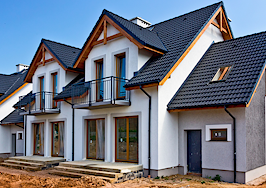Mark your calendars for the ultimate real estate experiences with Inman’s upcoming events! Dive into the future at Connect Miami, immerse in luxury at Luxury Connect, and converge with industry leaders at Inman Connect Las Vegas. Discover more and join the industry’s best at inman.com/events.
The U.S. housing market is short 7.2 million homes, according to Realtor.com’s latest housing market analysis. Nearly 18 million households have been formed over the past decade; however, only 10 million single-family homes were constructed during the same time period. It could take until 2029 for builders to close the gap.

Danielle Hale
“The U.S. is in a long-term housing shortage with the construction of new homes failing to keep pace with a growing population,” Realtor.com Chief Economist Danielle Hale said on Tuesday. “While a recent uptick in new construction has the potential to alleviate the historically low level of homes for sale on the market today, it’s going to take some time to close the gap.”
TAKE THE FEBRUARY INMAN INTEL INDEX SURVEY NOW
In 2023, homebuilders started construction on 947,200 single-family homes and 472,700 multi-family homes, which brought overall housing starts from 2012 to 2023 to 14.7 million. Sixty-eight percent, or 10 million, of those new housing starts were single-family dwellings.
During the same period, Americans began forming households at record speed, reaching 17.2 million new households by 2023.
The U.S. Census Bureau logged 1.7 million new households in 2023 alone, which widened the single-family housing inventory gap from 6.5 million in 2022 to 7.2 million in 2023. When multi-family housing is added into the mix, the inventory gap has widened from 2.3 million units to 2.5 million units.
To close the gap by 2028 or 2029, Realtor.com said homebuilders would need to triple their output of single-family homes. However, homebuilders could close the gap by 2026 or 2027 if they could increase their production by at least 50 percent.
According to the Federal Bank of St. Louis, the last time this kind of building growth happened was in 1970 when housing starts jumped from just under 1.5 million to an all-time high of 2.4 million in 1972.
The demand for affordably-priced new homes is robust, the report said, with 43 percent of new homes on the market selling for less than $400,000. Most new-home buyers are millennials (48 percent) and are more likely to have household incomes of $100,000 to $200,000 (30 percent) compared to existing-home buyers (22 percent).
At the metro level, permitting activity is behind household growth in 73 of the top 100 U.S. metropolitan statistical areas. San Antonio-New Braunfels, Texas; Austin-Round Rock, Texas; and Deltona-Daytona Beach-Ormond Beach, Florida, had the biggest inventory gaps in the nation, reaching as high as 5.1 percent.
Although builder sentiment reached an index of 34 in 2023, Hale said builders are doing their best to meet demand and are attracting homebuyers with impressive incentives.
“That said, the elevated level of both single- and multi-family construction coming to market this year is likely to put downward pressure on rent prices in many markets, welcome news for renters,” she said. “It also means that the higher than usual share of new homes for sale is likely to continue, giving home shoppers willing to consider new homes more options.”













